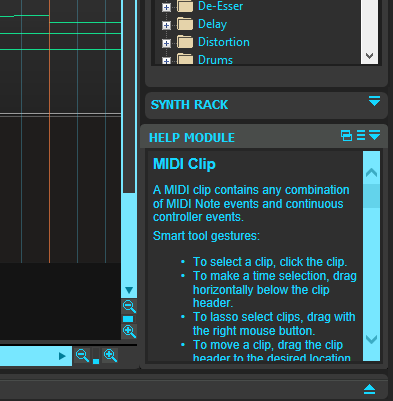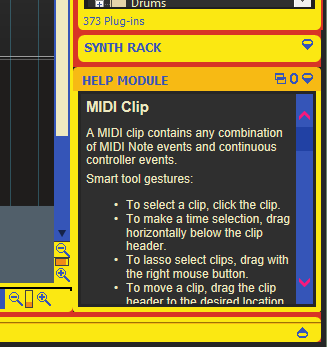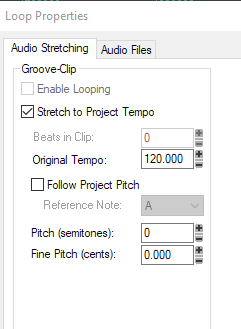-
Posts
8,664 -
Joined
-
Last visited
-
Days Won
30
Everything posted by Starship Krupa
-
Could you share which color in Theme Editor sets this? I'll need to check this in my themes.
-
In most areas, Cakewalk considers "Bypass" to be the active state in Theme Editor. Fortunately, we can provide a bit more clarity with custom button images. All of my custom themes (see sig for links) clarify the Mix Module buttons for FX bypass, PDC disable, and plug-in oversampling. The former show a red slash across the button when they're in "bypass" and the latter uses "1x" when oversampling is disabled. I also change the Pre/Post buttons in Console View's Send and ProChannel so that the default "pre" state says "Pre" rather than greyed "Post." Feel free to swipe the images.?
-
Excellent. This is where custom themes start to improve on the original UI choices in terms of basic usability. Those Mix module buttons drove me nuts. Next thing is to change the default Pre/Post button text so that it reads "Pre" when it's in that state. It's funny, but these things smooth the workflow by eliminating that moment of "okay, which state is it in again?" One of my Easter Eggs is what you see when you bypass all effects. It might be a local SF East Bay joke, but even if you don't get it, it's still descriptive. Yeah, I weighed the pros and cons of changing buttons as far as varying from the pictures in the documentation, but I decided to just go for it. It takes a certain amount of sophistication to load custom themes anyway, and I consider my buttons to be more intuitive (and certainly more visible) anyway.
-
It's subtle, I guess, but they show up when you have contiguous notes in a row. Plop down one and you get cells 5 and 6. Put two next to each other and you get cells 7 and 8 on the left and 11 and 12 on the right. Put down three and you get the aforementioned left and right, plus 9 and 10 in the middle. If you check out the shapes of the individual cells it gets clearer still. I hope this clarifies it. I figured it out by numbering each cell and then examining them closely. It helps if you slow your tempo way down. The hexagrams make it harder to see, but it's possible.
-

documentation Young Lady's Illustrated Primer to Theming Cakewalk
Starship Krupa replied to Colin Nicholls's topic in UI Themes
It was late and I couldn't think of a better term for 6 horizontal lines. I throw the I Ching from time to time. Double hamburgers? You got it just right (as usual), except the term I should have used for that was "highlighted." Anyway, I'm sure that anyone who wants to delve into it now has everything they need. I am so curious to find out if anyone other than me actually does anything with Step Sequencer, as it seems that the .STH Lords as a group maybe don't spend much time working in that view? I've been going through the views I use less to see whether there's something I can add to my workflow, and that's when I get more interested in making them more attractive. Anyone up for round cells in Step Sequencer? ? The hexagrams might be an issue there. -
Perhaps you already have, but the first things to check are whether snap is set to "to" or "by," and then in Preferences check "Snap Intensity." Also, check to see if Smart Grid is messing with you. When in PRV thing that helps me is to decouple the Track View snap from the Piano Roll snap and set the snap I need for notes, which is often different from what I need for clips.
-
So it's like the selection highlight in the Time Ruler, it chooses a color based on which color you set for the Ruler background.
-
I wouldn't mind another Metafilter license. That thing is whompin'.
-
Okay, mind blown. They have Guitar Player, Guitar World, and Guitarist as well. Thank you so much I'm sure you're not alone, but I do at least skim all of the articles. I got the free COVID year and then let it ride for another year because I get at least that much entertainment out of it, and dang, but they do have an archive of samples! A number of the CM suite plug-ins are daily users for me. ADM CM is my go-to for playing drum samples, G8 is great, JST/Boz Spatializer is my top fave stereo image tool. It's probably a lot like buying plug-ins and not using them; we get all excited about getting something new, but then realize we already have it. Processors, knowledge of digital recording methods, whatever. It's not a bad thing to brush up or get a new tip now and then.
-
Here's a snip of Midnight Blue, showing both my custom scroll bar colors and what the Help scrollers look like: Same view with Yellow Submarine: The red arrows in Yellow Submarine suggest that they may be controlled by a color selection elsewhere in the theme (or custom color settings, there's always that), although I'm not sure exactly where. It would sure be nice to have this scroll bar in the Browser instead of the generic non-themeable ones we have now. I kinda like the look of it, it would be nice to have everywhere else, too. Looks more modern, easier to see. I'd have to be able to change the colors of the arrows and thumb, though.
-
As all themers know, the Step Sequencer is just behind Matrix View as one of the first Cakewalk elements to attack when one sets out making a custom theme. Or maybe not. Well, in case you ever want to really make that theme unique and do up the Step Sequencer, I have decoded all 12 cells of the Step Sequencer / Step Button image. The Step Sequencer divides things into odd and even measures. Each step sequencer step can have 6 different states depending on whether it is in an odd or even measure, whether it's active (meaning you've clicked it to make a note sound), inactive (empty), and then whether it's highlighted because the playhead is currently over it. So if there are only 6 states, why do we have 12 cells? This is so rows of contiguous active steps can have rounded corners at each end. So in addition to all of the above, we also have images for the leftmost, middle, and rightmost active steps in a row, plus one for a single isolated step. This adds 3 button shapes plus their highlighted forms. Without further ado, I present the different cells of this button and what states they represent: Cell 1: Empty step in odd measure Cell 2: Highlighted empty step in odd measure Cell 3: Empty step in even measure Cell 4: Highlighted empty step in even measure Cell 5: Isolated step Cell 6: Highlighted isolated step Cell 7: Leftmost step in row of contiguous steps Cell 8: Highlighted leftmost step Cell 9: Inside step in row of contiguous steps Cell 10: Highlighted inner step Cell 11: Rightmost step in row of contiguous steps Cell 12: Highlighted rightmost step
-

documentation Young Lady's Illustrated Primer to Theming Cakewalk
Starship Krupa replied to Colin Nicholls's topic in UI Themes
Errata: p. 89 : "Step Sequencer / Step Button (Off)" and "Step Sequencer / Step Button (On)" Describing colors, they should both be Step Button Bar (Off) and Step Button Bar (On). They're used to display those "hexagrams" that appear atop active step buttons. Step Sequencer / Step Button is a a 12-cell image. All cells are used in the Sequencer, BTW. -
I never noticed that the module had scroll bars because I never have the Help Module open. Quick test on my system with EVA 01 and Yellow Submarine says that the colors are fairly congruent with Scroll Bar background, so maybe this is One of Those Things.
-

Detect and shift the pitch of an audio track
Starship Krupa replied to Starship Krupa's topic in Production Techniques
Well, I've gotten at least as far as: Open the clip in Loop Construction View. Select Clip/Clip Properties Check Stretch to Project Tempo That gives me access to the following dialog: It's kind of unintuitive to have to check "Switch to Project Tempo" when I want to keep the tempo and shift the pitch. It also leaves the heavy lifting of detecting the clip's original key to the user, but if I know how far off it is and just want to crowbar it up or down, it looks like Cakewalk can do it. Just seems like those fancy algorithms could be put to use here detecting the base pitch and key of the original clip. It looks like Cakewalk is doing a better job of tempo detection these days, but maybe I just fed it a better sample this time. -
If you use those images, yes.
-
Not to take anything away from VSTBuzz, but I highly recommend the 2-fer bundle that includes Boom. I bought the pair for $10 when Plugin Boutique ran a sale, and while I thought that I would probably use Drum Synth 500 more, Boom has become my standard go-to drum machine.
-

Detect and shift the pitch of an audio track
Starship Krupa replied to Starship Krupa's topic in Production Techniques
And again, I am puzzled by the (non) response. Is there perhaps another DAW that would be better suited to this task? -
Interesting and friggin' awesome.
-

BandLab acquires artist development platform ReverbNation
Starship Krupa replied to Sander Verstraten's topic in Deals
It's only taken 4 years for us to be able to connect the dots between freeware Cakewalk and actual revenue. Up to this point, BandLab seemed determined not to make any money from any of the platform's features (which include our fave DAW). I was a big BandLab rah-rah from day one, this is good to see. Do well by doing good. -
Me, too, with the sole exception of panning my drum overheads. I do find that with electronic music, the sounds I'm using often have huge stereo images baked in, so I have to be careful with big wide basses with a hole in the middle. Sum that down to mono and that bass can really build up. When I throw my own wideners on sounds, I stick to the ones that sum to mono well. And hit it with Panipulator at the end!
-
You do know that the current Cakewalk will throw a message about switching to WASAPI if it detects that you're using ASIO4ALL, right? A step in the right direction says I. It's good that this thread went the way it did, Amish rakefights aside. I think anyone reading it will get a good idea of the benefits of using WASAPI, getting an external interface and using its own ASIO driver, and the superfluous nature of ASIO4ALL (and other WDM wrappers like the Magix and Steinberg ones).
-
This is one of those things that I need to do from time to time that seems like it should be a lot more straightforward than it winds up being. I have a song from a movie soundtrack, and it sounds like they pitched the thing up by a few cents, not sure exactly how much, but what I want to do is nudge the whole track down so that can I add instruments to it. The instruments I'll be adding on are tuned to concert pitch, and I want it all in tune. First issue: analysis. What's the best way with the tools I have at my disposal (Cakewalk, Sound Forge Audio Studio, Mixcraft, Acid Studio, Melodyne Essentials, Quadrovox MAutopitch) to find out where it is now? Second issue: adjusting the pitch. What's the best way to nudge it about once I know how much I need to nudge it? I thought that Cakewalk and many others were supposed to have fancy algorithms to do detection and shifting? Are they not front-facing? Using Melodyne is, to me, like doing my income taxes. Happens about once a year, is a confusing, miserable chore, and I forget how to do it in between times. Besides, I get the impression that rolling those golden logs around is for single bum notes, not a whole song. Isn't this a basic thing in modern music production, matching the pitches of samples to make them work with other samples in a larger song? It seems like techniques for doing it would be less obscure. But when I've asked about it in the past, people have kind of scratched their heads and recalled a stranger who came through town years ago wanting to change the pitch of an audio track. Odd-looking fella he was, can't remember where he was from. Don't recall if he ever got an answer....
-

Need help mic'ing snare from underneath
Starship Krupa replied to Skeptik's topic in Production Techniques
If you're early in the process of learning drum mic'ing, you can ask yourself "do I actually need a reso side mic for my snare?" When I first started recording drums in my home studio, I dutifully mic'ed the reso sides of both the snare and the bass drum. I pretty much decided right away that the reso side mics were needless. I know this goes against common knowledge, but I love my recorded snare and kick sounds, and those other mics just don't add anything useful. The only thing possibly different about my setup is that I'm reeeeeally good at tuning drums. So my drums need very little damping, don't have odd resonances, etc. I don't know if that would matter as far as only using a single mic. I just point a dynamic at the batter head, aiming it at the center, at a about a 60-degree angle. Gives me all I need. If you decided that you want to use a reso side mic, don't worry about phase until you've got the recording in the box, then you can then either line the waveforms up visually or use a plug-in like MAutoalign. Flip the phase around and see what sounds best with each other and with the rest of the drum mix. -
Of course, my answer to everything is a free plug-in, but really, Boz Labs' Panipulator is a nice tool for checking mono compatibility before I finalize (ha ha) a mix. Lets you check everything, mono, L+R swapped, L only, R only, either out of phase, pretty much everything you need to know about how it will sound on the sound system that consists of a 1987 boom box with a single raw car speaker dangling from it by a lamp cord. I've heard that back in the Cakewalk SONAR days it came as a freebie ProChannel module too, but I'll never believe that until someone leaves a copy of the .dll laying around on a Google Drive....
-
Me, too. It doesn't get much simpler than plugging in a pair of headphones. ? Shoot, b, this is all supposed to be in good fun. If your response isn't just roughhousing (it's hard to know in this context), I'm truly sorry if I came off as attacking or too argumentative. I'm a geek, I'm curious about whether my beliefs about sound quality and latency ( that they'll both be better with the Audiophile) are borne out in testing. Not trying to prove that anyone's "right" or "wrong." Noel says that he tests Cakewalk on a system with a Realtek and gets decently low mixing latency, so I'm extra curious (that was not an Appeal To Authority, BTW ?). I agree with almost everything you've said. From where I stand, the only thing we seem to disagree about is at what point the budding recordist should invest $100+ in an audio interface. It's just earlier from your point of view than it is from mine. For you it seems to be ESSENTIAL NOW. For me, it's more "a good idea at some point." From my POV, someone running a rocket sled like that in MME 32 has issues to correct before shelling out for the interface. Numero uno, switch that thing to WASAPI ASAP. Numero dos turned out to be getting NON bluetooth cans. There are multiple reasons why a n00b might want to wait on buying an interface and do it out of expanded needs rather than under pressure of trying to get their system to play back audio smoothly. Maybe they're a young person with little income who just dropped some big coin on that motherboard and RAM and they have to juggle expenditures. Could be that the onboard CODEC was defective and a warranty issue will be uncovered. They advertise the onboard sound as being somehow fancy-pants, so he surely paid something for it. It's not the worst thing in the world for someone to listen to their stuff through a lower-end DAC for a while, get used to how it sounds. Then when they finally pop for the Scarlett (it's always a Scarlett, isn't it?), they can better appreciate the differences. Can we just have a difference of opinion? It doesn't have to descend into virtual fisticuffs when one guy says buy a new interface and another guy says hold on a sec. Does it? Heck, wouldn't a "producer" just download percussion samples? ? I was working on something recently where I was mixing and absently fiddling with one of those plastic LP Egg Shakers, and sure enough, I came up with a rhythm and just HAD to record it, in a continuous take the full length of the track. This when I have a Kontakt library of plastic fruit-shaped shakers, I have samplers and ROMPlers all with beautifully recorded shakers, but as the lord is my witness I rocked that sucker old school into the MXL2001. No edits. I'm like The Doors of plastic egg shakers, just nail that sucker and press it. If someone made a video it could blow up on YouTube: "Watch How This Grey-haired Wannabe 'Producer' Makes a Shaker Track." ?♂️







